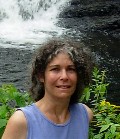Reading Our Region
Essays from a Regional Writer
 Susan Charkes enjoys hearing and telling stories, especially those involving the environment, farming, and sustainability in our region. Discover her poetic view of the outdoors and be inspired to visit the places she describes. Learn more about Susan, her writing, and even hear her podcasts at www.susancharkes.com.
Susan Charkes enjoys hearing and telling stories, especially those involving the environment, farming, and sustainability in our region. Discover her poetic view of the outdoors and be inspired to visit the places she describes. Learn more about Susan, her writing, and even hear her podcasts at www.susancharkes.com.
Sample these selected writings:
| Featured Items: |
Smooth or Chunky
by Susan Charkes
Now which way? I've reached the end of the woods trail; to return to the car, I can either walk the paved road that angles around the iced-over hayfield, or cut through the lumpy, muddy field. No contest. I take the shortcut, across the tussocky residue of last season's crop.
What appeals to me about this course is not just that it's a shortcut. It's that it requires effort. And that means it's not mind-numbing. Walking on uneven ground requires you to pay attention to the feel of the terrain and to anticipate obstacles ahead. One doesn't stride across the field; one tramps, up and over the mounded earth, bobbing on the shallow waves, making the walk a series of tiny challenges to balance and agility; each step provides a bit of information about the earth beneath one's feet. By the time I get to the parking lot I'm invigorated by the journey; if I'd gone the other way, I'd have been fixated on the end of the road.
For me, the road not taken is the preferable choice. Give me the soft ground next to the sidewalk, the trail made of mossy tree roots grasping a rocky slope. I'll sacrifice a quaint wooden footbridge in favor of hopping across stones in the creek.
Decades ago, researchers confirmed what nurses and waitresses have always known: walking on flat surfaces makes the feet sore and legs tired. We weren't meant to have a challenge-free life. People, it turns out, feel better walking and standing on rough uneven surfaces than they do on flat smooth floors and walkways. Unevenness stimulates blood vessel growth. It also strengthens foot muscles that assist in stability.
Indeed, according to a recent study, a rubber mat that simulates cobblestones provides equivalent benefits. Of course, where science runs, commerce follows. You can now buy bumpy mats to imitate nature's path if you can't find the real thing to walk on. Want something more portable? There's a new shoe design that puts the uneven surface under your feet wherever you go.
Although a woodland is my favorite place to walk, I regularly join the human hamsters on a treadmill in the Y, staring out the wall of windows at what passes for a view - the lawn. The bleak landscape is enlivened in winter by the spectacle of leaves, blown from the oak trees bordering the site, skittering across the ground and landing in apparently random clumps. After a recent snowstorm, clusters of brown leaves resting on the surface gave the whitened lawn a brindle coat. Because dark colors absorb the sun's warmth while light colors reflect it, the snow melted much faster around the leaves. The mottled surface gave rise to invisible currents of air as sunlight heated the dark leaves and the ground under them; the warm air rose, cooled and sank back.
The movement of air over the unevenly warmed lawn is in microcosm the same process of differential heating by which all surface winds develop. Winds arise from contrasts in color (dark vs. light), topography (mountain vs. valley), or material (water vs. land). The movement of air around the globe, and variations and contrasts between air masses, create our changeable weather. If the Earth were a smooth, uncluttered billiard ball instead of a rough-textured multicolored ragdoll head, life would be much less interesting.
Unevenness is what led to the creation of our planet in the first place. When the cosmos was forming, the fog of energy that turned into matter did so unevenly; areas with different densities acted like cosmic seeds, rather like airborne dust particles that attract cloud-borne water vapor and so form raindrops. These clumps of matter became galaxies, stars and planets.
No, I'd rather not smooth the course. It's unevenness that forces adaptation, roughness that stimulates creativity and resilience, variation that channels energy. On the PBJ of life, I'll take chunky.
© Susan Charkes 2006

